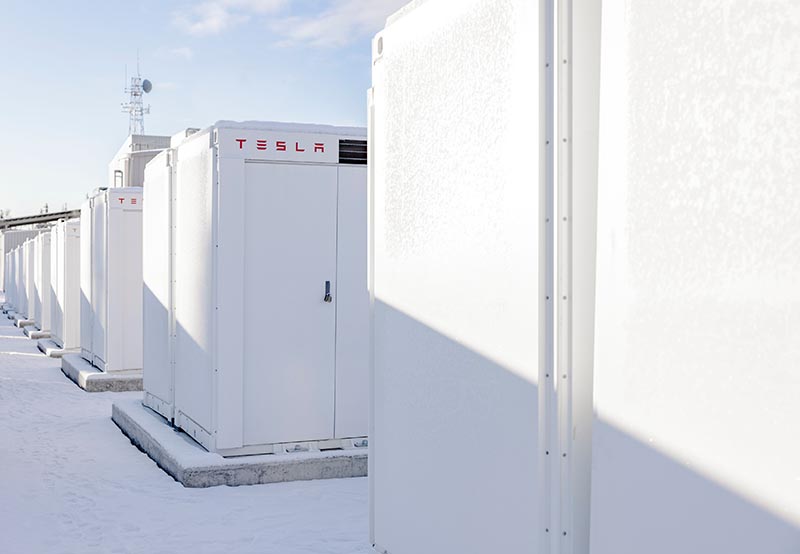
Energy storage: What goes up, must come down
Renewable technologies are essential to curb our addiction to fossil fuels and mitigate the impacts of climate change. In 2022, renewable energy from solar, wind, hydro, geothermal and ocean increased by around 8%, according to the International Energy Agency (IEA), and these technologies now account for around 5.5% of the global energy supply.
Variable renewable energy (VRE) sources such as solar and wind harness the power of nature to generate electricity without harmful emissions. They also offer the added benefit of improved energy security for oil-reliant countries. The problem, however, is the unpredictability of VRE. What do we do when the sun stops shining or the wind ceases to blow? On an industrial scale, electricity is rarely generated in reserve. There is a need for stable, reliable ways to store surplus energy so it can be used when it is needed and not simply wasted.
Batteries come in all shapes and sizes and are an increasingly popular solution for energy storage. Lithium-ion offers high energy density and currently dominates the battery market. The global lithium-ion battery market was USD45.70 billion in 2022, according to a report by Emergen Research in March 2023.

While batteries support the efficient management of energy, durability is a key drawback of conventional battery technology as storage capacity falls over time with continual recharging. Ecological damage associated with expanding lithium mining operations has drawn the ire of environmentalists. There are also concerns that battery technology is too expensive for use in power grids, with some experts suggesting green hydrogen offers a much better energy storage option.
Pumped-hydropower systems currently account for the majority (94%) of installed global energy storage capacity, according to the International Hydropower Association. Global installed hydropower capacity rose by 26 gigawatts (GW) to 1,360 GW in 2021. In this well-established energy choice, water is stored at higher elevations and released through turbines to generate electricity. However, the system relies on favourable topography, with water access and steep terrain a necessity.
A novel new technology—that Sir Isaac Newton would be proud of—is gaining increasing attention. “Gravity batteries” or gravitational energy storage systems (GESS) are a mechanical energy storage technology that relies on gravitational potential energy to store and release electricity.
In August 2023, Swiss-based Energy Vault completed construction and began commissioning the world’s first commercial, grid-scale GESS. The 400-foot-tall gravity battery building is located outside of Shanghai in Rudong, Jiangsu Province, China, adjacent to a wind power facility. The project was undertaken with partners Atlas Renewable and China Tianying, and has a capacity of 100 megawatt-hours (MWh) of energy which can be delivered at 25 megawatts (MW). Energy Vault has indicated that the facility will be fully grid-interconnected by the fourth quarter of 2023. A similar project is under construction in the state of Texas in the United States, for energy firm Enel. When completed, the 460-foot-tall structure will have 36 MWh capacity.
During its second-quarter results announcement, Energy Vault also outlined a licensing deal for its gravity battery technology in the United States and two energy storage projects totalling 500 MWh in Southeast Asia. The Southeast Asian projects will incorporate a variety of storage technologies including gravity batteries and green hydrogen. The company also noted interest in their proprietary technology in Europe, the Middle East, Australia and China.
So, what exactly is a gravity battery? They bear no resemblance to your typical AA battery or the unit that powers your electric vehicle. These enormous, so-called batteries, work by raising heavy objects to a higher elevation when excess energy is available and lowering them to generate electricity when it is required. The technology is evolving and can be co-located with solar or wind plants or connected directly to the grid to support grid stability.
Energy Vault’s GESS concept is inspired by pumped hydro plants that rely on gravity and the vertical movement of water. The Swiss solution includes a series of cement/polymer-based composite bricks that can be constructed using low-cost materials destined for landfills. These enormous, 35-tonne slabs are hauled 35 stories up and when lowered at a speed of 1.9 metres per second can generate one MW. GESS is designed to be modular, enabling flexible plant capacity, and offering 4-8 MW of continuous power discharge for 8-16 hours.
Gravity batteries offer a cost-effective energy storage option that does not rely on explicit geography. Energy Vault claims the technology can provide energy savings of 70% compared to current technologies such as hydrogen plant pumps and turbines. They are less complicated than hydrogen storage and do not pose the same environmental concerns associated with the mining of critical rare metals. Gravity batteries require simple maintenance, and there is no degradation of capacity throughout their lifespan. However, they are yet to be proved at scale.

Several new operators are entering the fray. Scottish start-up Gravitricity is looking to take gravity batteries underground through the use of decommissioned mine shafts. The company believes there are approximately 14,000 mines worldwide that could benefit from the technology. On the surface, it appears to be a good use of infrastructure and resources in disappearing mining locations. They are also working on below-the-surface green hydrogen storage.
Gravitricity operates a scale-version pilot plant in the Edinburgh port of Leith with a 15-metre-high steel tower, and the company has previously confirmed plans for its first full-scale system in 2023-2024. The Scottish company closed a crowdfunding raise in May 2023 for its underground energy storage technology having raised GBP829,000 (USD1 million).
In February 2023, Gravitricity and Czech Republic state enterprise, DIAMO, agreed to advance plans to turn a decommissioned mine in the Czech Republic into a 4 MW/2 MWh plant. At the time, Charlie Blair, Gravitricity managing director, said the company hopes the collaboration “will allow us to demonstrate this technology at scale and offer a potential future for coal mines that are approaching the end of their original service life.” Gravitricity has also made a move to secure funding in the U.S. market, partnering with IEA Infrastructure Construction to access U.S. President Joseph Biden’s GBP363 million (USD446 million) clean energy fund.
Gravity Power has a slightly different take on this new “battery” technology. The California-based start-up is also opting for underground gravity storage in deep shafts but is combining water and gravity to store power. In their concept, a piston of reinforced rock drops, forcing water up the penstock and through the turbine, spinning the generator to produce electricity. The Gravity Power website indicates that the approach can return energy to the grid at about 4¢ per KWh, less than half the cost of lithium-ion, including the cost of energy lost in the round trip.
While interest in gravity batteries is increasing, some commentators have cast aspersions on this novel solution to energy storage needs. Concerns have been raised around the practicality of the approach with some challenging the fragility of crane systems, emissions associated with the construction of concrete blocks, and the relatively small amounts of energy produced.







